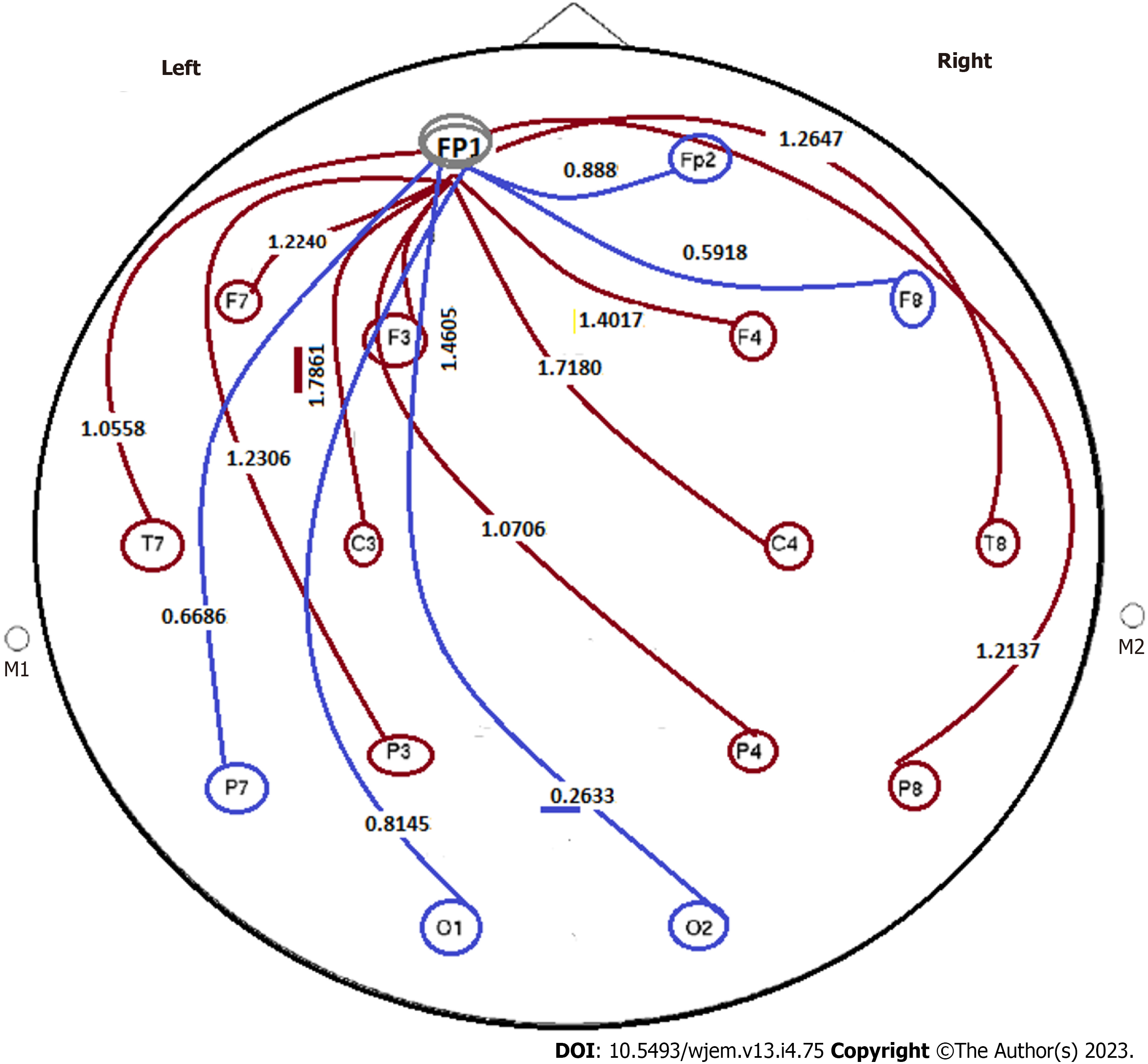Copyright
©The Author(s) 2023.
World J Exp Med. Sep 20, 2023; 13(4): 75-94
Published online Sep 20, 2023. doi: 10.5493/wjem.v13.i4.75
Published online Sep 20, 2023. doi: 10.5493/wjem.v13.i4.75
Figure 11 Power ratio at pre- to post applied condition of closed/open eyes in an apparently healthy individual.
By considering the applied condition- model as closed/opened eyes, evaluation was performed by considering the ratio of FP1 to other channels: (1) Minor group: Cooperation from polar section of brain, i.e., between FP1/Fp2 = 0.888; FP1/F8 = 0.5918; FP1/O2 = 0.2633; FP1/O1 = 0.8145; FP1/P7 = 0.6686. All ratio < 1. Range of ratio: 0.2633-0.8145; (2) major group: have diverse destinations including FP1/T8 = 1.2647; FP1/P8 = 1.2137; FP1/F4=1.4017; FP1/C4 = 1.7180; FP1/P4 = 1.0706; FP1/F3 = 1.4605; FP1/C3 = 1.7861; FP1/F7 = 1.2240; FP1/P3 = 1.2306; and FP1/T7 = 1.0558. All ratio > 1. Range of ratio: 1.0558-1.7861. In this image, FP1 is the unique station as the primary initiating action within the brian channels, as octopods. There is a uique pattern as one direction from the upper to lower-section of the brain, including 10 indices less than 1 ratio (the blue lines) and 10 indices higher than 1 (brown lines). Such remarkable diversity is indicative of the well defined as two opposite directions from a unique central station towards 20 destinations. By defining the status of closed- to open eyes including > 1 as relaxation and < 1 as stressful conditions, then the challenging points are related to two distinct-outcomes. But as the matter of fact, the imposed rule is the unique major initiator, as the main station towards two categorized destinations. This regulation is considered as: (1) The correlative/single station, as major initiator/hypothesis; and (2) two distinct Ratio based categories, including > 1 and < 1 (Figure 11). The question is related to the diverse impact on the behavioral, emotional and other related physical and/or mental behaviors. Keeping the stable behavioral balances is the major aim with the reliable, harmless, and available tools such as light music and/or any relaxation method. This data reflects: (1) An EEG, personalized based and reliable categorized hypothesis; (2) with aim of detecting the behavioral characteristics of both group of individuals including an apparently healthy and individuals with either affected with Alzheimer disease, or at primary stages of AD; (3) considering an early detective strategy; and (4) organizing the prognostic, predictive, and preventive management as early as possible. F: Frontal; O: Occipital; C: Central; FC: Between F and C; AF: Between Fp and F; C3,4: Central Lobe; F3,4,7,8,z: Frontal lobe; FP1,2: Pre frontal cortex; PF3,4,7,8: Partial Lobe; O1,2: Occipital lobe; T7,8: Temporal 7,8.
- Citation: Mehdipour P, Fathi N, Nosratabadi M. Personalized clinical managements through exploring circulating neural cells and electroencephalography. World J Exp Med 2023; 13(4): 75-94
- URL: https://www.wjgnet.com/2220-315X/full/v13/i4/75.htm
- DOI: https://dx.doi.org/10.5493/wjem.v13.i4.75









